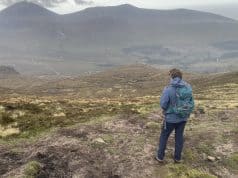There’s a lot more to a warm night’s sleep than just bringing along your warmest sleeping bag. Follow these simple tips to ensure the best possible night’s sleep on the trail and a productive next day.

As someone who frequently camps both after and before a day’s work, or on multi day trips, I’m pretty fond of a proper night’s sleep in the hills. Resting better enhances every aspect of your camping experience and is crucial if you’re to enjoy regular long distance hikes and short notice camps.
Bring an adequate sleeping system
You know your own body better than anyone else. Do you sleep warm? Do you leave the heat on at night in the house? Forget about following temperature ratings to the letter and remember your own body temperature is what drives how comfortable you are – regardless of the bag rating. Those who sleep warmer can use a lighter bag, those who sleep cold need a warmer bag. This may seem obvious, but it’s a common sense axiom that many abandon when confronted with the myriad “Comfort” and “Extreme” ratings manufacturers throw around.
Don’t forget the importance of a really good sleeping mat, which reduces heat loss through the ground, maximising your warmth. Inflating and closed cell sleeping mats are the most popular because of their comfort and weight.
Our current favourite is the Thermarest Neoair xTherm which we have reviewed over the course of a year’s use.
Don’t be afraid of down
Down loses its thermal properties when wet! The cries are audible already. Truth is for a down bag to fully fail you need to get it properly sodden. Anyone who has had to wash one by hand can attest to this. Buy a proper compression drybag and look after your kit to keep it dry.
Down provides a much higher warmth to weight ratio than synthetic fills, meaning you’ll sleep warmer while carrying less weight. Also the softness of down makes it noticeably more comfortable than synthetic alternatives. Sleep with your compression drybag nearby and kept dry and even while bivvying, a down filled sleeping bag will keep you warm through the night.
You are the heat source – fuel it!
A sleeping bag doesn’t warm your body. It merely traps the heat your body produces to allow you to remain warmer. If your body is exhausted and unable to produce proper warmth, you will remain cold regardless of the bag rating.
Eat a robust, fatty meal just before bed to fuel your thermogenesis. Fat is harder for your body to break down than other food sources, hence why many people eat a fatty food before bed – your body will generate more heat breaking down the fat than it will carbohydrates or sugar. A lump of butter in your hot cocoa or a bowl of hot stew will certainly do the trick.
If you’re wearing a fleece and it’s still dry, climb into your bag before taking it off, so the heat it is trapping is brought into the bag with you. If you still feel cold while in the sleeping bag, do a few situps to warm up quickly and generate heat to be trapped by your sleeping bag.
Also – keep hydrated. Being dehydrated leads to lower heat production, headaches and generally a terrible night’s sleep – if you sleep at all.
Loft Early
When compressed, sleeping bags temporarily lose their insulation potential as the surface area for trapped air between the fibres / down plumes is reduced. Once it’s out of the compression bag, air is drawn in, the bag expands and insulation potential is restored.
Don’t lay inside your sleeping bag waiting for your bag to loft. As soon as you arrive at camp, set up your shelter and assemble your sleep system, then leave your bag to loft (expand) while you go build your fire and entertain yourself for the evening. At every camp the first thing I do is throw down my bivvy bag and insert my mat and sleeping bag, zip it shut to keep it dry and go off to leave it lofting. Coming back to a puffy, lofted sleeping bag at the end of the night is the smart choice.
Deal with condensation
While a down bag will never get soaked if proper precautions are followed, condensation can build up in the bag during normal breathing and perspiration. Over a prolonged trip this can lead to a heavier bag which takes slightly longer to loft.
Pitch in an area with a decent breeze to keep the air flowing. If possible, air your bag in the sun in the morning, just like the picture in the title. Just remember to keep your bag raised off the grass in case of morning dew.
Tighten those baffles
Sleeping bags come with drawcords for a reason, they allow you to draw the bag in tighter to your body around areas like the head and shoulder to prevent warm air from escaping. Once you get comfortable, tighten your hood and shoulder baffles to keep the warm air in. A warmer head temperature aids earlier sleep, so even if you are uncomfortable with using the hood, wear a hat or balaclava to keep your head warm during the night.
Bring Earplugs
Heavy rain pounding your bivvy bag or winds flapping your tent can prevent sleep sometimes even when you’re worn right down from the day before. Earplugs block most of this out, allowing you a bit more peace and quiet and a deeper night’s sleep.
Use a buff as a blindfold
In spring / summer sunrise can be very early, and tents don’t do much to stop light from reaching your eyes. While it is nice to rise early and watch the sunrise, it can also be nice to have a lie in after a hard days walking. Use your buff or scarf to make a blindfold by rolling it over your eyes – it might not seem comfortable at first, but it definitely does make a difference.
Everyone sleeps differently. While the above steps may not be totally foolproof, they’re certainly a good start. With a little more attention to the right details, you can be sure of a strong night’s sleep so you can remain productive the next day, be it for another day of hiking, or a day at the office. Did we miss any tips? Tell us in the comments and we will add them!






Great piece! Haha, I learned the hard way about ‘lofting early’ when I was on one of my first ‘extreme’ treks a few years back. Definitely helps to let the thing have a bit to do it’s thing! I was freezing for far too long! Way better to wait by the fire and get warm first!